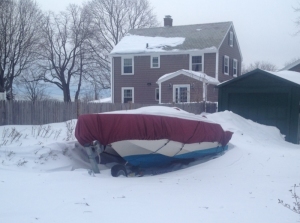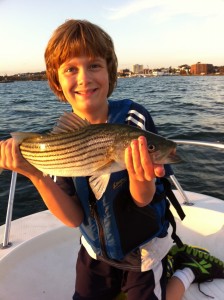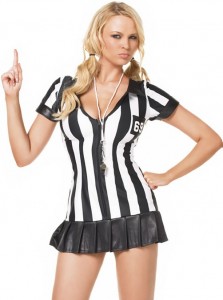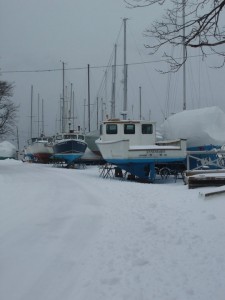







A site dedicated to discussion of these classic boats
22 Feb, 2015 1 Comment
Filed in: servicing, storage, winterizing
 I haven’t had much opportunity to post in recent months–let alone do any work on the boat. Seatoad sits in the driveway under a mantle of snow and ice. this winter has been particularly harsh–over eight feet of snow in Boston and still a month to go until spring. A few weeks after Christmas I pulled off the cover long enough to lay a bunch of planks across the gunnels. Good thing or the snow would have collapsed the cover long ago.
I haven’t had much opportunity to post in recent months–let alone do any work on the boat. Seatoad sits in the driveway under a mantle of snow and ice. this winter has been particularly harsh–over eight feet of snow in Boston and still a month to go until spring. A few weeks after Christmas I pulled off the cover long enough to lay a bunch of planks across the gunnels. Good thing or the snow would have collapsed the cover long ago.
This afternoon I finally got around to starting a preliminary spring to-do list for the boat. There’s a lot that needs doing.
The rest of the items are related–one way or another–to the repower I did last spring. While the new engine itself is great (a Honda 4 stroke) the work done by the service center was awful–sloppy and rushed despite taking six week. They even broke a few things on the boat in the process.
what I need to fix:
24 Oct, 2012 5 Comments
Filed in: fishing, winterizing
 End of the season up here in Boston and I pulled my Wahoo! from the water yesterday. Although I would have hauled out anyway due to the lateness of the season, if I needed any other reason Hurricane Sandy, currently just south of Cuba’s southeast tip, looks like it will give the US East coast its first (and likely only) tropical storm of the year early next week.
End of the season up here in Boston and I pulled my Wahoo! from the water yesterday. Although I would have hauled out anyway due to the lateness of the season, if I needed any other reason Hurricane Sandy, currently just south of Cuba’s southeast tip, looks like it will give the US East coast its first (and likely only) tropical storm of the year early next week.
2012 was my third year as a Wahoo! owner and the best so far. Lots of quality time on the water. Many problems solved, but still no shortage of tweaks I’d like to make to the boat next year. Thanks to the many Wahoo! owners who contribute to and read this blog. It’s been a lot of fun sharing experiences and learning from you guys. Boston Harbor, when the wind and chop are up, can be a pretty rough ride. So three years in I still feel like I’m getting to know this my 16.2’s capabilities, especially in big water. Once thing I know for sure though, when she planes on a flat surface, what an amazing ride! Like a magic carpet.
This past week my friend Gary C. of Philadelphia was here. Every year in the fall Gary comes up for a short week and we go striper fishing. This year winds gusting to 30 mph kept us off the water much of the time but we managed to have a few nice days and my son Ben (pictured) took his first stripers from my Wahoo!
Now the boat’s in the driveway. Time to get busy winterizing before the cold sets in.
16 Jan, 2012 No Comments
Filed in: football, legal, servicing, storage, winterizing
 The whole month of December without a single post! After a busy boating season I needed a little down time. But it’s time to get busy again. Been working on some bugs/enhancements to the gallery/upload pages and got most of it figured out yesterday while watching the NFL divisional round games (the Giants look like they’re peaking at just the right time…they’re going to be very tough).
The whole month of December without a single post! After a busy boating season I needed a little down time. But it’s time to get busy again. Been working on some bugs/enhancements to the gallery/upload pages and got most of it figured out yesterday while watching the NFL divisional round games (the Giants look like they’re peaking at just the right time…they’re going to be very tough).
Finally (finally!) in the first week of January got the boat tarp/cover fixed on in such a way that it won’t blow off in a high wind or cave in and pull loose after a heavy rain/snowfall. Up to this point I had the tarp tied with sash cord. But a good rain would load the top of the cover with water causing it to belly down into to boat. This in turn would stretch and loosen the sash cord, and then the next really wind day would just lift the whole thing off. I solved the bellying issue by cutting a bunch of wooden slats to the width of the boat and then laying them atop the gunnels (plywood would have worked too but I figured that’d be heavier and more awkward to put on and off). I solved the loosening problem by doing what you’re supposed to do…affixing the cover with heavy duty bungee cords.
The battery is still in the boat, instead of down in the basement on a trickle charger like it should be. I wanted the option of still being able to raise and lower the motor. But now that we’re into the truly frigid months here in Massachusetts it’s time to put it where it belongs.
Tasks for the month:
Shopping lists for boat/trailer parts and fishing equipment will have to wait until February.
9 Nov, 2011 No Comments
Filed in: servicing, winterizing
 Winter haul out of the Seatoad went smoothly, thanks especially to my friend Dave who was in town for the weekend and helped out. Dave is a serious sailor…owns a 45 foot catamaran, the Luna Sea, which he and his lady Susan sail year round between Maine and the Caribbean. Dave is well-versed in all things nautical, including engines. In fact, when it comes to boats, I can say with confidence that Dave knows what he’s doing.
Winter haul out of the Seatoad went smoothly, thanks especially to my friend Dave who was in town for the weekend and helped out. Dave is a serious sailor…owns a 45 foot catamaran, the Luna Sea, which he and his lady Susan sail year round between Maine and the Caribbean. Dave is well-versed in all things nautical, including engines. In fact, when it comes to boats, I can say with confidence that Dave knows what he’s doing.
So I asked him about something I’ve been puzzling over recently …is there a real difference between the gear case oil they sell for cars (which goes for as cheap as $4 a quart) and the gear case oil they sell for outboards (which can go for as high as $9 for eight ounces–$36 a quart!). By gear case oil, I mean the lubricant that goes into your outboard’s lower unit. Depending on the brand it may be marketed as gear oil (or lube), lower unit oil (or lube), and a bunch of other names. (The various names, I suspect, are partly aimed at keeping you guessing.)
The standard viscosity for both auto and marine outboard gear case oil is the same…SAE 80W-90. So is there really a difference? Or is this just another case of boat owners getting ripped off?
Dave was refreshingly candid. Not missing a beat he said “Regular old gear oil is all I’ve ever used in my engines” (he has both outboards and inboards). “It’s the same stuff.”
But I’d heard that marine gear case oil was different: that it has additives to keep it low foaming–important to keep you from blowing a seal. And it’s tackier, so that any moisture finding its way into the unit can’t get between it and a metal surface, causing separation.
Dave shrugged. “Yeah, they might add a little anti-foaming agent, but a good oil shouldn’t be foaming anyway. Foaming is usually caused by water contamination not by some failure of the oil itself. And a lower unit is sealed. Keep the water out and you won’t have an issue. Get water in and no oil’s gonna make up for that.”
So after talking to Dave there was no way I was ever spending $9 for an eight ounce tube of Mercury Gear Lube again. But I also wasn’t quite ready to go with the very cheapest WalMart has to offer. So I compromised: Lucas Heavy Duty High Performance Gear Oil (Trans and Diff Lube), $8 a quart at Auto Zone. And to make me feel a little more comfortable with the choice, the back label states “Excellent for use in outboard final drives.”
Good enough for me. ![]()
A few loose notes…
21 Oct, 2011 2 Comments
Filed in: servicing, winterizing
 Even as I look for fair days to eke the last out of the fishing season here in Boston, I’m looking ahead to winter. And with a boat in a slip that means two things: haul out and winterizing.
Even as I look for fair days to eke the last out of the fishing season here in Boston, I’m looking ahead to winter. And with a boat in a slip that means two things: haul out and winterizing.
“Haul out” is the day the boat needs to be gone from its slip. The Point of Pines Yacht Club has decreed that to be this Saturday. Given the screwy and limited access to usable boat ramps around here, haul out means first driving the trailer down to the Nahant Town Wharf, then hitching a ride over to the POPYC six miles away by car, and finally running the boat three miles across Broad Sound to the trailer. The many rocks and shoals between Point of Pines and Nahant make that journey a lot safer to undertake when the tide is high. Unfortunately this Saturday high tide is at 6 a.m. ![]()
Winterizing of course is the process of getting the boat ready for winter storage; basically six months of sitting. The goals of winterizing are pretty simple but worth listing out:
findre August 9, 2015
findre August 9, 2015
findre August 9, 2015
Lcolon7 June 23, 2015
MikeQ June 24, 2015